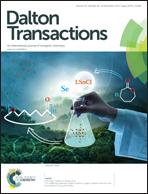Syntheses, structures, and magnetic properties of homodinuclear lanthanide complexes based on dinucleating Schiff base ligands†
Abstract
The first two families of homodinuclear lanthanide(III) complexes, formulated as [(LOEt)2Ln2(L1)] and [(LOEt)2Ln2(L2)] (Ln3+ = Dy3+, Tb3+, Ho3+, Gd3+, and Y3+; L14− = 2,2′,2′′,2′′′-[1,2,4,5-benzenetetrayltetrakis(nitrilomethylidyne)]tetrakisphenolate; L24− = 2,2′,2′′,2′′′-[[1,1′-biphenyl]-3,3′,4,4′-tetrayltetrakis(nitrilomethylidyne)]tetrakis(4-chlorophenolate); LOEt− = (η5-cyclopentadienyl)tris(diethylphosphito-p)cobaltate(III)), were successfully synthesized based on Kläui's tripodal building block NaLOEt and two dinucleating Schiff base ligands, H4L1 and H4L2, respectively. Single-crystal X-ray analyses show that these lanthanide complexes have two seven-coordinated metal binding sites, linked to each other with a phenyl or biphenyl bridge. Variable temperature dc magnetic measurements reveal the weakly antiferromagnetic coupling between paramagnetic lanthanide ions, while ac magnetic data exhibit the field-induced relaxation of magnetization for the corresponding Dy2 complexes 1 and 6. A further magnetic dilution study for 1 suggests that the slow magnetic relaxation originates from the single-ion magnetic behaviour of Dy3+ ions.


 Please wait while we load your content...
Please wait while we load your content...